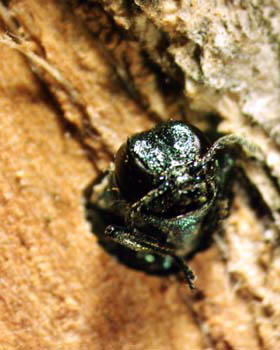Second largest city becomes latest victim of devastating menace
Ag Communications
By Jennifer Stewart
June 28, 2007
 |
EAB Adult Emerges
J. Zablotny, USDA APHIS |
WEST LAFAYETTE, Ind. - Indiana's second largest city is the newest place where emerald ash borer can be found attacking the urban forest.
While the insect had previously been confirmed in Allen County, the city of Fort Wayne had not yet had a confirmed infestation - until now.
"When the insect was found in Allen County, we suspected it would only be a matter of time before it was confirmed in Fort Wayne," said Jodie Ellis, Purdue University entomologist. "It's highly unfortunate because Fort Wayne has a higher than average ash population than do most cities."
When emerald ash borer is found in Indiana, the townships in which it is discovered, as well as the entire county, are quarantined for ash products. The newest finds in Fort Wayne mean quarantines for both Adams and Wayne townships. Cedar Creek Township remains quarantined from a find near Grabill in 2006.
On its own, emerald ash borer will travel only about a half mile annually. Most new infestations are a direct result of firewood movement, or the movement of other ash products from place to place.
"The main thing to remember is not to move firewood from place to place," Ellis said. "Now, more than ever, it is especially important that people buy firewood at their destination and burn it fully before leaving."
Since emerald ash borer was first found in the United States near Detroit in 2002, developments in insecticides have made it possible for people to protect individual ash trees from infestation.
In addition, there are several resources available from Purdue, the Indiana Department of Natural Resources and the United States Department of Agriculture-Animal Plant Health Inspection Service (USDA APHIS), designed to help people slow the spread and deal with this invasive pest.
"People need to be aware that there is information and help available to them," Ellis said. "There are treatment options now that don't necessarily involve having to remove healthy ash trees in urban areas."
More information on options for dealing with emerald ash borer is available by visiting http://www.entm.purdue.edu/EAB/index.shtml or by calling 1-866-NO EXOTIC. Information also is available in Spanish at http://www.entm.purdue.edu/EAB/espanol/index.shtml.
Ellis is also available for questions by calling (765) 494-0822 or by e-mailing ellisj@purdue.edu.
Writer: Jennifer Stewart, (765) 494-6682, jsstewar@purdue.edu
Source: Jodie Ellis, (765) 494-0822, ellisj@purdue.edu
Ag Communications: (765) 494-2722;
Beth Forbes, forbes@purdue.edu
Agriculture News Page
|